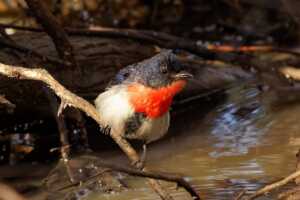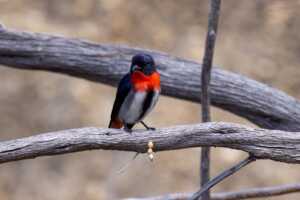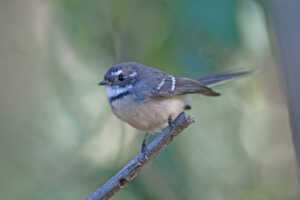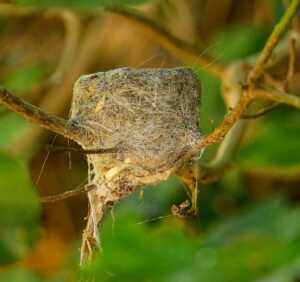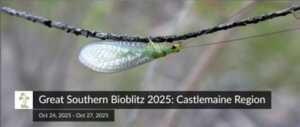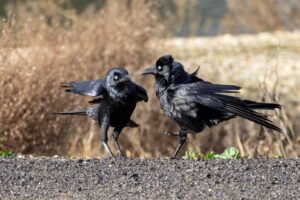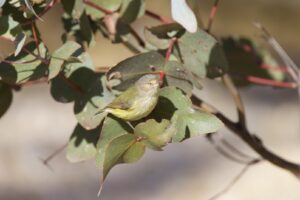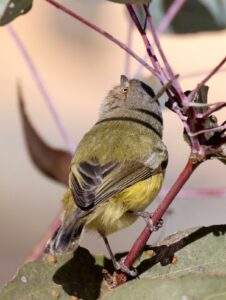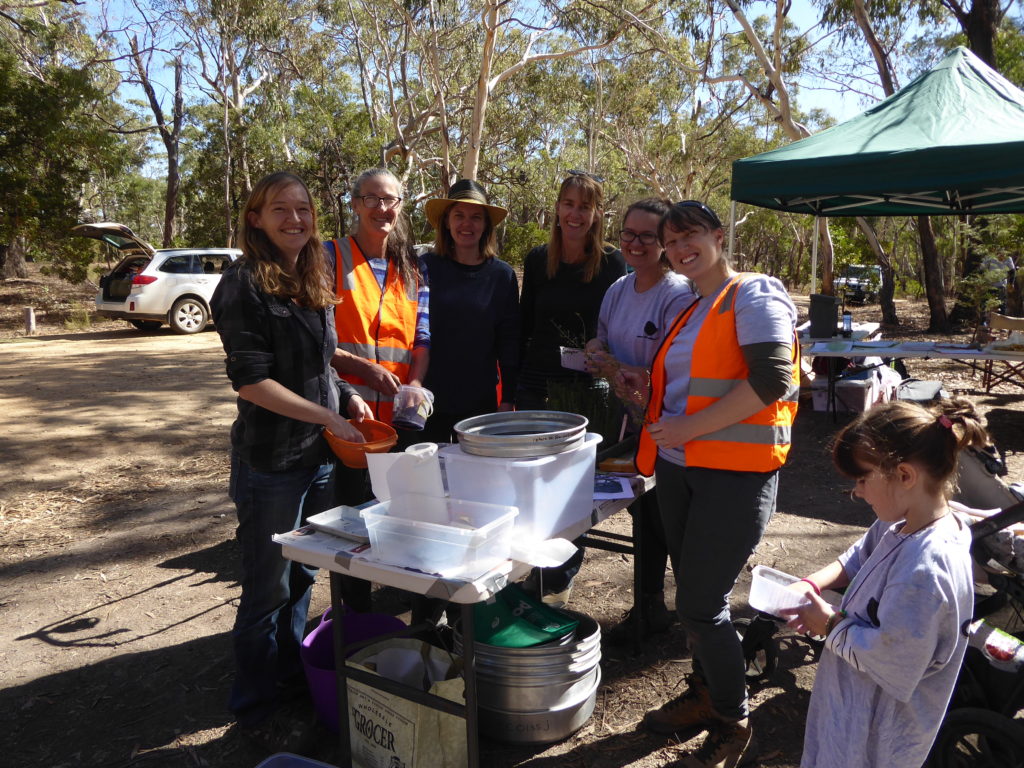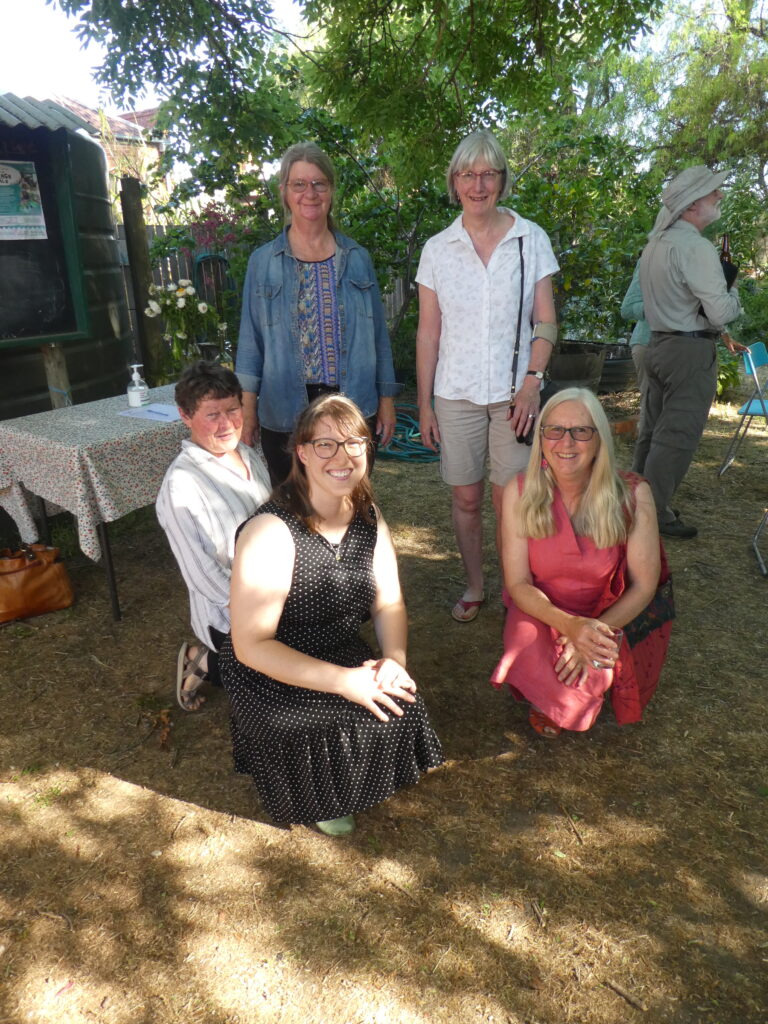Bird of the month: Mistletoe Bird
Posted on 28 November, 2025 by Lori
Written by Damian Kelly and Jane Rusden.
The high squeaky call of the Mistletoe Bird (Dicaeum hirundinaceaum) is what often signals its presence. Then the search is on to find the tiny bird, keeping a look out for the males vibrant fire engine red splash on its chest and under tail coverts. Given its name, it is not surprising that the Mistletoe Bird specialises in mistletoe – a plant that parasitises other plants. Specialisation in one plant may sound a little restricting until you find that there are about 75 different species of mistletoe in Australia. Clearly lots of variety is around.
The close symbiosis, a situation where two species “use” each other and both benefit, between mistletoe and the Mistletoe Bird possibly demonstrates the most highly developed example of this phenomenon amongst Australian birds. This bird is a major vector for the dispersal of the seeds of the plant, spreading them to potential new host trees. Timing of breeding tends to coincide with flowering and fruiting and so assists with cross-pollination and seed germination. The unusual structure of the birds’ digestive system emphasises the degree of specialisation that has evolved. The berries pass through the alimentary canal, but the structure of the digestive system allows for berries to be shunted from the oesophagus to the intestine whilst insect food is diverted to the stomach. Mistletoe seeds are passed about 15-20 minutes after ingestion. It appears only the skin of the berry is removed revealing the very sticky coating, this ensures that a lot of the seeds actually stick to trees as the bird moves about. A completely different take on plant fertilisation. Why the Mistletoe Bird wants to spread seed for the mistletoe plant seems to be a mystery, but perhaps it’s because it harbours so many insects, which are a mainstay food source for the bird?
The distribution of Mistletoe Birds is all over Australia except for some of the drier desert areas, but not Tasmania, and it is resident on some Torres Strait islands. Habitat type does not seem to matter as long as there are mistletoes and with 75 species chances are good that they are present. They also eat a range of insects gathered from foliage.
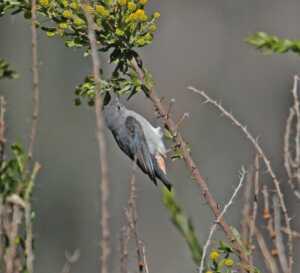
Female Mistletoe Bird, she is grey rather than black and lacks the bright red chest. Photo by Damian Kelly
Nests are precariously suspended from the end of a twig in foliage. It is an enclosed pear shape and is made from lots of soft materials such as wool, woollen threads and such like, and is held together with spiders’ web. A clutch of 2-3 eggs is laid and both parents feed the young – initially only on insects but then also with berries.
A largely sedentary species, they remain in an area all year round although some altitudinal migration has been demonstrated in NSW and Victoria over winter. Banding studies have recorded 98% recovered within less than 10km of the banding site. The oldest bird recorded was over 9 years old which is a fair age for such a small bird.
Mistletoe often gets a bad rap, …except at this time of year when apparently, it’s good for kissing under! But before you think badly of this parasitic group of plants, perhaps think instead of the huge number of species each plant supports, including the beautiful Mistletoe Bird.
Bird of the Month is a partnership between Connecting Country and BirdLife Castlemaine District. Each month we take a close look at one special local bird species. We are blessed to have the brilliant Jane Rusden and Damian Kelly from BirdLife Castlemaine District writing these! We’re excited to join forces to deliver you a different bird each month, seasonally adjusted, and welcome suggestions from the community.
Bird of the Month: Grey Fantail
Posted on 20 October, 2025 by Lori
Words by Damian Kelly and Jane Rusden. Photos by Damian Kelly
Always a delight to watch, the Grey Fantail (Rhipidura fuliginosa) swishes its tail around directing insects into easier catching distance. And then there’s their tinkling call, often heard before the bird is seen. Luckily for us bird watchers, Grey Fantails can be very curious, which means they come much closer to us than many other species. They do have rather a disapproving look on their tiny faces, characterised by their drawn down white eyebrows.
A confiding and widespread species, the Grey Fantail can be found all along the wetter eastern and western areas of Australia and occasionally spreading into drier areas inland. Tasmania, New Zealand and other islands also have populations of this species.
Urban gardens are also utilised and here in Castlemaine, in our garden near the centre of town, a pair of Grey Fantails has successfully fledged young for the last two years. The nest is concealed in dense vegetation right next to a garden path, but human traffic does not seem to concern them. Whenever I walk past, a beady eye is watching me, but the bird never leaves the nest. Two young were raised each time which is quite a feat given the tiny size of the nest. Built from small twigs, grass and hairs and held together with spiders’ webs, the nest is a beautiful construction. The nest from two years ago was simply refurbished with more web prior to the second season of breeding (see photo).
Although not fully understood, the movements of Grey Fantails are a mixed bag. In some areas populations are partly or fully sedentary, whilst in other areas migration takes place. Movements can be driven by food availability and temperature. There seems to be a whole east coast movement of birds. All in all, a mixed bag of movements. I can report that the birds who breed in our garden are not present over winter but have returned now as spring advances.
Some of the Tasmanian birds migrate to the mainland over winter. Groups of Grey Fantails have been regularly recorded moving across King and Flinders Islands on the way to the mainland. There are probably some altitudinal movements, but this is often confused by other movements occurring. At times small groups up to 30 birds can be seen moving through areas.
Feeding tends to be arboreal, often catching prey in flight, although they will also feed on the ground. Food consists mainly of insects, but they occasionally take fruit or seeds. Often associated with mixed feeding flocks moving through vegetation.

Grey Fantail utilising prickly cover of Gorse, (an invasive weed), with its tail characteristically fanned. Photo by Damian Kelly.
Bird of the Month is a partnership between Connecting Country and BirdLife Castlemaine District. Each month we take a close look at one special local bird species. We are blessed to have the brilliant Jane Rusden and Damian Kelly from BirdLife Castlemaine District writing these! We’re excited to join forces to deliver you a different bird each month, seasonally adjusted, and welcome suggestions from the community.
Great Southern Bioblitz – Castlemaine Region 24-27 October
Posted on 16 October, 2025 by Lori
It’s the beginning of October and so wonderful to see the new growth and increasing activity in bushlands and gardens after so many months of challenging conditions. Trees, shrubs and other understorey plants are putting out new leaves and foliage, and canopies are becoming denser. Birds are calling and nesting. Frogs are croaking. Thankfully insects are about again, albeit not in good numbers yet, but Painted Ladies and some day moths are about. And we are already being treated with the bright colours of Myrnong, Waxlips, Leopard orchids and Caladenias, with scattered clusters of emerging leaves promising Helmet and Gnat orchids.
Hopefully while all of this is happening those of you who live in or visit the Mount Alexander Shire will be getting ready for the Great Southern Bioblitz 2025,which runs from midnight October 23 to midnight October 27. This is your opportunity to join other citizen scientists to help build the scientific databases that increase the knowledge and understanding of our bushlands and their biodiversity. These annual Bioblitz surveys collect vast amounts of data on species and distribution that would otherwise be unavailable.
The Castlemaine Field Naturalists Club are again hosting a count in this region and they’d love your contributions! If you can contribute, all you need is a camera or phone and enthusiasm!
You’ll find lots of information, including deadlines, tips on uploading your images to iNaturalist, the online global databank for observations of biodiversity and more on the Castlemaine Field Naturalists Club Great Southern Bioblitz webpage.
Images: Castlemaine Field Naturalists Club
Bird of the month: The Corvids – Ravens and Crows
Posted on 18 August, 2025 by Lori
Article by Damian Kelly and Jane Rusden

Little Ravens (most likely) at Coliban Waters Castlemaine Water Treatment Plant Bird Hide. (Photo Jane Rusden)
At the brand new bird hide put in by Coliban Water at the treatment plant in Castlemaine *, waterbirds and waders are the obvious focus when bird watching. However, a pair of what I believe are Little Ravens were caught goofing around in a very silly display, quite unlike the often cooler demeanor we usually see in this species. The sighting led us down the Corvid “rabbit hole”. Reading on, you’ll discover why I have not definitively stated which of our two local species the photos are of.
Although ravens are not always popular with people for various reasons, it is important to acknowledge that they perform an important scavenger role in cleaning up dead wildlife as well as eating a variety of agricultural insect pests as well as seeds. They are omnivorous and feed mostly on the ground. Ravens have adapted to a wide variety of habitats and are common around farms as well as cities, and obviously Water Treatment Plants.
Australia has five species – Australian Raven, Little Raven, Forest Raven, Torresian Crow and Little Crow. To quote the Handbook of Australian and New Zealand Birds (HANZAB): “All Australian Corvus are very difficult to distinguish and great care is needed to identify species.” Even the experts can be confused!
Whilst on the face of it all species look similar, in reality it is fairly easy to identify a species based on location – in most areas only one or two species are present. Around the Mount Alexander region we only have two species – Australian Raven and Little Raven and the Little Raven is far more common. Travelling further afield of course can be tricky. And unless you want a bird identification head ache, you don’t want to be in the north coast of NSW where all five can be found.
Locally the Little Raven is the most common and can be seen in large groups out of breeding season. Calls of our two local species are quite different with the Australian Raven tending to be longer and more drawn out than the Little Raven. You are best to listen to the calls on a birding app on your phone to become familiar with each, as trying to describe sounds in words is often not a lot of use.
Working out the age of a bird can be done by checking out the iris of the eye: adults are white with a bluish ring around the pupil, immatures are brown and juveniles blue-grey. Other indicators sometimes used to aid identification such as the throat hackles or colour at the base of feathers are often not much use in the field.
Pairs of Australian Ravens are generally sedentary and defend their territories all year round whereas Little Ravens move a lot, only defending small territories during breeding season and then joining large mobile flocks after breeding. These movements have been recorded over distance of several hundred kilometres at times, specially with juvenile and immature birds.
Nests are usually an untidy collection of sticks with a softer internal lining high up in large trees. Both parents build the nest and feed the young, but only the female does the incubation. Currently there is a pair either renovating or building a nest high up in the Big Tree in Guildford.
In many Aboriginal language groups, the raven is seen as a trickster or hero. Ravens have been recorded using tools such as sticks to retrieve food such as larvae from logs or dropping items on hard surfaces to crack them open. They also store food in caches for later use and can remember the location for long periods. Hikers’ packs are also fair game as ravens have learned to open small pockets and even sealed bags. Some field zoologists have had to stop nest monitoring surveys of threatened bird species (or at least their route between nests) if an Australian Raven is in the area, as they learn to follow the researchers, find the nests and predate the chicks.
A pair of what we believe are Little Ravens, goofing about … perhaps strengthening their pair bond, at Coliban Waters Castlemaine Water Treatment Plant Bird Hide. (Photo by Jane Rusden)
* Note: to access the birdhide at the Coliban Water Treatment Plant, email communications@coliban.com.au to sign the access agreement form and apply for a key.
Bird of the Month is a partnership between Connecting Country and BirdLife Castlemaine District. Each month we take a close look at one special local bird species. We are blessed to have the brilliant Jane Rusden and Damian Kelly from BirdLife Castlemaine District writing these! We’re excited to join forces to deliver you a different bird each month, seasonally adjusted, and welcome suggestions from the community.
Bird of the Month – Weebill
Posted on 22 July, 2025 by Bonnie Humphreys
Written by Damian Kelly and Jane Rusden
In the local Box-Ironbark forest it’s fairly rare to go for a walk without hearing the Weebill. Although seeing it can be tricky, as typically they are in constant motion as they forage in amongst foliage. A give away is their hover, similar species don’t exhibit this behaviour. The best interactions I’ve had with Weebills, is when I’ve been sitting quietly nature journaling in my sketchbook, and a flock moves through the scrub around me. In these instances they can come very close to you and no binoculars are required to get fantastic views of the tiny but sometimes bold bird.
Measuring from bill tip to tail at 80mm and weighing in at just 6 grams, the Weebill is Australia’s smallest bird, but not by far with the Brown Thornbill just 1 gram heavier on average. As its name implies the bill is also very small and and stumpy which makes it easy to distinguish in the field from other Thornbills that invariably have longer, pointy thorn-like bills. It has been placed in a different genus to the other Thornbills.
A glance at the distribution map for the Weebill shows that it is widespread throughout Australia apart from some inland deserts and tropical rain forest areas. Detailed banding studies have shown the Weebill is a sedentary species with little local movements. Recoveries of banded birds have shown the 99% were recorded less than 10km form original locations. And surprisingly for such a small bird, some recoveries have been of birds over 7 years old.
Food is mostly insects of various kinds, although at times seeds are also taken. Breeding usually occurs August-December, although nesting has been observed at any time of the year when conditions are suitable. Nests are dome-shaped and are built mainly in eucalypt foliage. Clutch size ranges from 2-4 eggs. Both females and males incubate and feed the young.
Calls are quite loud for such a small bird with a whistled song that is quite distinctive and can sound like it’s calling its own name, “Weebill”.
Bird of the Month is a partnership between Connecting Country and BirdLife Castlemaine District. Each month we take a close look at one special local bird species. We are blessed to have the brilliant Jane Rusden and Damian Kelly from BirdLife Castlemaine District writing these! We’re excited to join forces to deliver you a different bird each month, seasonally adjusted, and welcome suggestions from the community.
Protecting large, old habitat trees in Metcalfe
Posted on 27 June, 2025 by Bonnie Humphreys
Sarah lives on her family’s farm in Metcalfe. The 30 hectare property has been managed for sheep grazing for many years. While sheep are still agisted within the property, Sarah has her eye on habitat creation and the restoration of indigenous flora across the property – ‘We’ve been adding to the remnant and revegetated areas every year and are already seeing a big increase in birds.’ Saray says.
Sarah’s property has an ephemeral (seasonal) creek line, grassy paddocks, and scattered large old Eucalypt trees, mainly Yellow Box (Eucalyptus melliodora), River Red-gum (Eucalyptus camaldulensis), Long-leaf Box (Eucalyptus goniocalyx) and some Manna Gum (Eucalyptus viminalis). Sarah loves these large old trees ‘These giant old trees are so precious, it’s so good to see them fenced off and protected from hard hooves and nutrient overload, and to see the understory we have planted start to grow up underneath which will soon be full of birds’.
Connecting Country has been very lucky to secure support from the Ian Shirly Norman Foundation in partnership with the Victorian Government NatureFund to run a program over the past 2 years to protect large old Eucalyptus trees within farmland in the Mount Alexander Shire, and to provide succession for the next generation of these to mature. These large old trees are scarce in our landscape, largely due to historic gold-mining, timber harvesting and clearing for agriculture. These trees are so critical for habitat for a range of animal species, particularly threatened species such as the Brush-tailed Phascogale that relies on tree hollows for nesting.
Some key actions within the project included;
- Fencing to exclude stock. Stock increase nutrient loads around trees, as well as introducing weeds and compacting the soil.
- Retaining fallen limbs and leaf litter. These provide homes for insects, foraging resources for small animals and birds, and protection for the soil.
- Planting of understorey species around the trees. This helps provide resources and habitat for animals, who in turn, help manage pests. These plants also provide some direct protection for these large trees.
- Installation of nest boxes. Phascogale nestboxes were installed throughout the property support the threatened species to breed and move through the landscape.
- Providing stock proof guards to protect strategic recruitment of trees within paddocks.
- Controlling pests such as weeds and rabbits

With funding from our project partners, Connecting Country was able to support Sarah to be a step closer to achieving her goals and vision for the property. In June last year she held a planting day. ‘We had around thirty people come and help plant the trees and had a bush dance the evening inviting everyone in Metcalfe. It was so much fun and people are excited to come back next year, see how far the trees have come and plant lots more’.
The plants are off to a great start, especially given the extended dry we have been having and are already popping out of the guards. ‘I can’t think of many better feelings than watching a fairly barren, grazed landscape come back to life, shoot up and begin bursting with biodiversity again’.
Connecting Country is very proud to be able to support properties like Sarah’s and to work with such an enthusiastic and committed community. We acknowledge and are very grateful to the Ian and Shirley Norman Foundation and the Victorian Government (through the Nature Fund) for supporting this valuable work.
Weed of the Month: Blackberry
Posted on 16 June, 2025 by Bonnie Humphreys
Most people can recognise a blackberry plant, but did you know that what we consider to be Blackberry consists of around 26 different species we refer to as an aggregate – Rubus fruticosus agg. These plants were first imported to Australia in the 1830s for gardens, as hedgerows, and as food plants. In the 1850s they were recommended to be used for erosion control along creeks but by the 1880s, they were recognised as weeds. Harbouring rabbits and reducing the quality of farm land they were listed as noxious in Victoria in 1894.
Blackberry originates from Europe, North America and Asia. It is a prickly woody shrub which sends out long woody canes that take root and spread. It also grows from roots and root fragments, and from seed readily eaten and spread by many animals including birds and foxes. It effectively grows in sun and shade and can successfully compete and overtake existing vegetation. Blackberrys usually have a period of dormancy throughout the year, and in our area, this usually occurs over winter.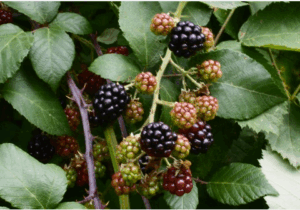
It is listed under the Catchment and Land Management Act 1994 as ‘regionally controlled’ which means that landholders and managers have ‘a responsibility to prevent the growth and spread of this plant’.
It is also considered a weed of national significance (WONS) which means that it is considered noxious across the whole of Australia. There is a taskforce especially formed to deal with community education and the control of this species across Victoria – Click here
Herbicide application is the most common form of control, with an integrated approach usually most successful. Manual removal is limited to very specific situations due to the plants ability to regrow from most parts of the plant and in particular root fragments. Spraying and slashing may be used for extensive infestations, but will require follow up. As it is a woody weed the ‘cut and paint’ method of control is very effective. Any herbicide application should only occur when the plant is healthy and actively growing.
Further information can be found within the Blackberry Control Manual – Click here
Or on the Castlemaine Field Naturalists Website – Click here
The Weed of Month article is a segment from Connecting Country’s ‘Partnerships Against Pests’ project funded by Agriculture Victoria in 2024-25. Through this program, Connecting Country is working closely with local community groups, such as Landcare, to raise awareness of local pest plant and animal issues, with the aim to empower community with the skills to address these threats. The project includes seasonal awareness campaigns around key pest issues as well as workshops, and market stalls across the region.
Photos: Castlemaine Flora website
Bird of the Month: Australian Hobby
Posted on 26 May, 2025 by Lori
Article by Damian Kelly with a small addition by Jane Rusden
My research for this article quickly found that the Australian Hobby (Falco longipennis) has been little studied and there are some gaps in its background. This is surprising as it is fairly common in cities and towns including Melbourne, Adelaide and Canberra as well as being found around Castlemaine. Just the other day a Hobby swept across in front of me as I drove down Urquhart Street near the centre of town. They have a preference for using old raven nests when breeding. Once, up near Kerang, I watched an epic battle between a pair of Little Ravens and two Hobbies over the possession of a nest high in an old River Redgum. In this case the hobbies appeared to win the day and at least one raven egg was removed from the nest and smashed on the ground.
Breeding generally occurs in spring and the female lays 2-4 eggs. Both sexes incubate and feed the young. After fledging the family group stays together for up to 12 weeks. Often the parents will do food transfers in flight to improve the abilities of the young.
The Hobby is sometimes confused with the far more charismatic Peregrine Falcon it resembles. It is distinguished from the Peregrine by its smaller size and slighter build with only a partial “helmet” compared to the Peregrine. It also tends to have a brownish breast.
Interestingly, the Latin name ‘longipennis’ comes from the birds long primary wing feathers. Penna singular and pennae plural, is feather in Latin. In ornithological terms, penna refers to a contour feather.
Outside of urban areas the Hobby can be found all over the country from coastal areas to the dry interior and Tasmania. Nesting generally occurs near water. In some areas it is resident but birds often move about with some evidence of north-south and altitudinal movements. Quite an adaptable bird.
They catch birds, bats and insects on the wing often via fast contour hunting hugging the treetops, along creek lines, between buildings or by direct diving from a perch. Diet is primarily birds (70%), with parrots and starlings more common, along with dragonflies. Surprisingly they also are known to take the fast-flying White-throated Needletails. As a crepuscular (at twilight) species it can be observed feeding towards dusk and around dawn, hence the appearance of bats in their diet. It is not unusual to see a Hobby sitting high in a tree watching and waiting for prey.
Bird of the Month is a partnership between Connecting Country and BirdLife Castlemaine District. Each month we take a close look at one special local bird species. We are blessed to have the brilliant Jane Rusden and Damian Kelly from BirdLife Castlemaine District writing these! We’re excited to join forces to deliver you a different bird each month, seasonally adjusted, and welcome suggestions from the community.
Bird of the Month: Jacky Winter
Posted on 17 February, 2025 by Anna
Jacky Winter (Microeca fascinans)
Welcome to Bird of the Month, a partnership between Connecting Country and BirdLife Castlemaine District. Each month we’re taking a close look at one special local bird species. We are blessed to have the brilliant Jane Rusden and Damian Kelly from BirdLife Castlemaine District writing these! We’re excited to join forces to deliver you a different bird each month, seasonally adjusted, and welcome suggestions from the community.
The Jacky Winter is one of the “Feathered Five’ indicator species selected by Connecting Country for their detailed 10-year Woodland Birds Action Plan for the Mount Alexander region. There have been noticeable declines in this species’ with the clearing of woodland in many parts of Australia. A handy way to find them, is to look along fence lines where paddocks butt up to bushland, as they love to perch on the fence wires preening or keeping an eye out for insects to eat for lunch.
Although it is a member of the generally colourful family of robins, the Jacky Winter has a more subdued colour palette of pale grey, white and brown, which allows it to blend in to the environment. Males and females are very similar in appearance. Also both sexes can be easily confused with female Hooded Robins, but the Jacky Winter is paler on the chest, it’s bill is slightly shorter and the white stripe down the side of the tail is continuous. To add to the confusion, both species’ distributions overlap considerably. Jacky Winters prefer areas of open woodland, and can be found over large parts of Australia, as well as extending into Papua New Guinea.
In suitable habitat it can be easily observed with its typical feeding behaviour of hawking for insects using the ‘sit and pounce’ tactic typical of several different robins, where it sits on a low branch and then dives down to catch prey on the ground. They can often be seen in pairs whilst feeding. Food includes a range of insects and arachnids. Given the chance they are also known to be partial to cheese. Not unusual as I have experienced similar behaviour from a Brown Treecreeper pinching cheese from my lunch.
In their breeding season they build a very small, cup-shaped nest mainly composed of twigs and bark and held together with spiders’ web. Clutch size is usually 2 eggs. Only the female incubates the eggs, but both parents feed the young. Unlike other Australian species, there is no evidence of helpers at the nest – all work is done by the breeding pair.
Long-term studies indicate that Jacky Winters are generally sedentary and remain in an area throughout the year. There is very little evidence of migration apart from some local seasonal movements. This sedentary aspect of their behaviour makes this species more vulnerable when habitat is cleared.
2024 Great Southern BioBlitz – 20-23 September
Posted on 10 September, 2024 by Anna
Castlemaine Field Naturalists Club is again hosting the Great Southern Bioblitz for the Castlemaine region. GSB24 runs from September 20 to 23 2024 with citizen scientists from across the Southern Hemisphere photographing and audio recording as many living species as possible within their regions.
Get involved and help showcase all the amazing forms of wildlife living in our own Castlemaine region and help build the scientific databases that increase knowledge and understanding of our bushlands. These annual Bioblitz surveys collect vast amounts of data on species and distribution that would otherwise be unavailable.
To join the fun take photographs or make sound recordings of flora, fauna and fungi between 20-23 September. You have until 7 October 2024 to upload them to iNaturalist from your phone app or computer. iNaturalist is a global databank for observations of biodiversity made by scientists, naturalists and citizen scientists. Then skilled naturalists, scientists and other citizen scientists will help you identify as many of your observations as possible. If you’re unsure on how to use iNaturalist, the Field Nats will be running a Beginners Guide to iNaturalist on Wednesday 11th Sept at 7pm (bookings required at https://www.trybooking.com/CUPWG )
There are a series of events hosted by Castlemaine Field Naturalists Club, as part of the Bioblitz. See below for details.
Friday 20th – Monday 23rd September – make your observations and attend the following special events. Observations must be from the Mt Alexander Shire or the eastern half of Hepburn Shire including Daylesford and Trentham.
Friday 20th Sept from 7pm: Moth Night
Moths hold vital roles in ecosystem biodiversity. They are an important food source and great pollinators. The majority of species are nocturnal and most of these are attracted to light. Come along to watch these moths flying onto illuminated moth sheets and be amazed at the variation in sizes and colour of these beautiful creatures. A moth scientist will be on site to help with identification.
We will set up the lights and moth sheets at the southern end of the Castlemaine Botanical Gardens near the Walker St bridge (Opposite The Mill).
Sunday 22nd Sept. 1:30-3:30pm, followed by afternoon tea. Bioblitz Afternoon in the Bush. All Welcome
As part of Bioblitz 2024, we are offering the opportunity to spend a very special afternoon in the bush with four of our highly regarded local wildlife experts. Immerse yourself in the sights and sounds of the bush and record what you see and hear with photos or audio.
Bring your phone, camera, binoculars, magnifying glass and unbridled, childlike curiosity! And a cup for afternoon tea. If you wish, bring something for afternoon tea to share afterwards.
Meet at the Red White and Blue Picnic Area in Muckleford Forest – click here for directions.
Friday 20th Sept to Monday 7th October. Load and Identify
During this time, load your observations made between 20th and 23rd Sept to the iNaturalist platform. They will be automatically included in our GSB24 project. https://inaturalist.ala.org.au/projects/great-southern-bioblitz-2024-castlemaine-region. You can also help identify the observations that others have made.
Want a challenge? Can you make and load more observations than our very own “Babblerboy” who in 2023 recorded 799 observations of 256 species – no. 17 globally!
Bird of the Month: Australasian Grebe
Posted on 19 June, 2024 by Ivan
Welcome to Bird of the Month, a partnership between Connecting Country and BirdLife Castlemaine District. Each month we’re taking a close look at one special local bird species. We’re excited to join forces to deliver you a different bird each month, seasonally adjusted, and welcome suggestions from the community. We are blessed to have the brilliant Jane Rusden and Damian Kelly from BirdLife Castlemaine District writing about our next bird of the month, accompanied by Damian’s stunning photos.
Australasian Grebe (Tachybaptus novaehollandiae)
Australasian Grebes hold a special place in my heart, simply because they have such cute fluffy bums and can often be seen on dams. They are seemingly half fish, spending their lives on or under water. They nest on rafts and can spend long periods under the water foraging. On land they are quite ungainly and walk very awkwardly. And then there’s the chicks, the cutest striped balls of fluff riding on a parent’s back, tucked safely away in a bed of living feathers.
Appearance can vary quite a bit. In the breeding season, both males and females have a glossy-black head with a chestnut stripe on the face extending from behind the eye through to the base of the neck and a distinctive yellow patch below the eye. In contrast, the non-breeding plumage of both sexes is dark grey-brown above with silver-grey below and lacks the distinctive yellow patch. Juveniles are quite different again, with camouflage-type black stripes on grey plumage.

Juveniles are quite different again, with camouflage-type black stripes on grey plumage. Photo: Damian Kelly
They are adaptable and can be found in varying habitats from small farm dams to larger bodies of water. Food includes fish, snails and aquatic arthropods usually collected by diving. Grebes are also known to eat their downy feathers and feed feathers to their young. Various reasons have been suggested for this behaviour ranging from aiding digestion to assisting the formation of pellets to help eject fish bones, but definitive reasons are yet to be determined.
Grebes are known to be quite mobile and will fly to new areas as water levels change. Flight is generally undertaken at night. They have also colonized New Zealand in recent times.

The Australasian grebe is common on freshwater lakes and rivers in greater Australia, New Zealand and on nearby Pacific islands. Photo: Damian Kelly
Nests are a floating mound of vegetation that is usually attached to a submerged branch or other fixed object. Over a season, two or three clutches of 3-5 eggs are laid. At times two females may lay in the same nest. Young can swim from birth and are fed by both parents. However, if a second clutch is laid the young of the previous brood are driven away.
To hear the call of the Australasian Grebe, please click here
Bird of the Month: Brown Goshawk
Posted on 23 January, 2024 by Ivan
Welcome to Bird of the month, a partnership between Connecting Country and BirdLife Castlemaine District. Each month we’re taking a close look at one special local bird species. We’re excited to join forces to deliver you a different bird each month, seasonally adjusted, and welcome suggestions from the community. We are blessed to have the brilliant Jane Rusden and Damian Kelly from BirdLife Castlemaine District writing about our next bird of the month, accompanied by Janes’s stunning photos.
Brown Goshawk (Accipiter fasciatus)

Solid looking Brown Goshawk in Campbells Creek, showing the heavy brow, long rounded tail and middle toe is similar length to other toes. Photo by Jane Rusden
Observed one morning when walking through the bush on my block, a Brown Goshawk pursued an Australian Owlet-nightjar in a fierce dog fight, flying at full speed down the gully, dodging trees by millimetres. The Brown Goshawk managed to catch the desperate Owlet-nightjar just before they saw the two humans, then they tumbled to the ground still locked together. the poor little Owlet Nightjar looked stunned and worse for wear, while the Brown Goshawk flew up into a tree, reluctant to loose it’s prey. The Owlet-nightjar at least got a bit of a breather, before both birds went their separate ways. I have no idea if the Owlet-nightjar survived the lethal body-puncturing talons of the Brown Goshawk, but the Goshawk certainly went hungry that morning.
The Brown Goshawk is one the Australia’s most widely distributed raptors and can be found across Australia and Tasmania as well as other islands, although it not as common in the very dry areas inland. It is a very versatile predator that uses a wide range of hunting techniques and can target a wide variety of prey. It will stalk grasshoppers on the ground, pursue small birds through the air and sit unobtrusively in cover, ready to glide down to catch prey on the ground. This prey ranges from insects to quail along with small rabbits, mice, lizards and snakes as well as yabbies and at times, carrion. Prey is usually 500g or less, but items such as young rabbits and reptiles up to 1kg have been known to be taken by female goshawks which are much larger than the male. Owlet-nightjars weigh 35-65g, putting them firmly in the small bird category of prey.

Choosing dinner. A Brown Goshawk terrorising rescue aviary Cockatiels, but the Cockatiels are thankfully very safe from this fearsome predator. Photo by Jane Rusden
The Goshawk is also well known for lurking around chicken coops and aviaries looking for dinner opportunities, as well as soaring up high on the lookout for prey. It is known to be a reckless and persistent hunter, chasing birds through the undergrowth, exactly like the Goshawk chasing the Owlet-nightjar down the gully, and at times will chase prey into or under buildings. Young goshawks, in particular, have a reputation for being quite reckless at times when chasing prey, dashing through dense foliage and into chicken pens.
Although quite common and widespread in both bushland and urban areas it often goes unnoticed due to its cryptic behaviour, sitting very still in foliage and silently observing with intense yellow eyes.
The introduction and spread of the rabbit along with the opening of forests has probably led to an expansion of its range since European settlement.
Nests are built usually in the fork of a tree out of sticks and foliage. 1- 5 eggs are laid (usually 2-4) and both parents will incubate and feed the young. Adults tend to be fairly sedentary but young birds have been know to spread quite long distances in their first year, with some banding re-captures over 900km from a nest site.
Identification
The Brown Goshawk can be tricky to distinguish from the closely related Collared Sparrowhawk. Although the female Goshawk is quite a bit larger at 45-55cm in length, the female Sparrowhawk (35-38cm) is almost as large as the male Goshawk (38-45cm). Colouration and habitat tend to be similar and differentiating the two species can be hard in the field, especially when you only get a fleeting glimpse of these fast and cryptic birds.
In short, the best indicators to separate them are as follows:
Find more information on Brown Goshawk, including their calls, here.
Pollinator heroes of Central Victoria: Common Halfband Hoverfly
Posted on 30 November, 2023 by Ivan
With spring upon us, now is the perfect time to take a closer look at the smaller pollinator heroes of our region! There is plenty to see and hear across all habitats across central Victoria if you stop and pay attention to the little things. Throughout the warmer months the bees are buzzing, butterflies are fluttering, beetles are looking for mates and wasps are making nests. There is plenty to see and hear across all habitats in central Victoria if you stop and pay attention to the little things. These wonderful pollinating creatures are the heroes of the bush, grasslands, our gardens and waterways.
The Buzz project: promoting pollinators of central Victoria, is a Connecting Country project funded by the North Central Catchment Management Authority (NCCMA) through the 2022 Victorian Landcare grants, that aims to celebrate and expand community knowledge on the smaller heroes of our local ecosystems, the insect pollinators. As part of this project, we have explored the lives of some of our most loved native pollinators from across the local region through a series of blogposts throughout November. This is the final blogpost in this series, with the hero of focus from the endearing hoverfly family.
Dr Mark Hall, local entomologist, has kindly shared his extensive knowledge on some of the local pollinator heroes that are so important to the health of our ecosystems.
Common Halfband Hoverfly (Melangyna viridiceps)
Words by Dr. Mark Hall
Hmm, is this a bee? It certainly looks a bit like one with those bright yellow bands. And it is visiting lots of flowers. No, this is actually a fly trying to mimic a bee. Thankfully there are some tell-tale signs to tell the two apart. See those really big eyes, and the very short antennae? Unlike bees that have oval eyes on the sides of their head, fly eyes are typically much larger and rounder, sometimes taking up most of the head. And the antennae are shorter in flies, whereas bees have longer, segmented antennae. And that’s not where the differences end.
Flies are often more abundant in cooler climates, such as higher-up mountains, and can forage in colder weather (so can be more active than bees in early spring in this region). Whereas bees will often be more direct in their fight for flowers, hoverflies spend a lot of time flying above flowers, seemingly surveying for the perfect one before landing. Like bees, they feed almost exclusively on flowers (their larvae eat aphids) and are very good pollinators. They are fast flyers like bees, but they do lack the branched hairs that make bees exceptional pollen carriers.

The Common Halfband Hoverfly is a slim-bodied fly with reddish brown eyes, dark thorax and black and yellow banded abdomen. Photo by John Walter.
The Common Halfband Hoverfly can be found across most habitats in south-eastern Australia and in the southwest, including quite arid environments. They will feed on the nectar and pollen of many different types of plants and can also be confused with other hoverfly species, most typically the Yellow-shouldered hoverfly (Simosyrphus grandicornis), which is also common and abundant.
Why not take the opportunity to slow down this spring and take a look in your local bushland or garden and see what pollinator heroes you can find?
Pollinator heroes of Central Victoria: Imperial Jezebel
Posted on 21 November, 2023 by Ivan
It’s springtime and the flowers are blooming, the bees are buzzing, butterflies are fluttering, beetles are looking for mates and wasps are making nests. There is plenty to see and hear across all habitats across central Victoria if you stop and pay attention to the little things. These are the heroes of the bush, grasslands, our gardens and waterways.
The Buzz project: promoting pollinators of central Victoria, is a Connecting Country project funded by the North Central Catchment Management Authority (NCCMA) through the 2022 Victorian Landcare grants, that aims to celebrate and expand community knowledge on the smaller heroes of our local ecosystems, the insect pollinators.
The project has been running throughout 2023 and has included a presentation with local entomologist Dr Mark Hall covering ‘Native pollinators on your property: who, where and what they do?’ followed by a field trip that took a further look into ‘promoting native pollinators from property to landscape.’
During November, we will explore the lives of our most loved native pollinators from across the local region. Dr Mark Hall, local entomologist, has kindly shared his extensive knowledge on some of our local pollinator heroes that are so important to the health of our ecosystems.
Imperial Jezebel (Delias harpalyce)
Words by Dr. Mark Hall
With Christmas approaching, you may hear the familiar tune of “I saw mommy kissing Santa Claus, underneath the mistletoe…”. And while that particular type of mistletoe is not native to Australia (and in fact is an environmental weed), there are a number of plants we call mistletoe in Australia that are native and have another species “kissing” underneath them at this time of year. The mistletoes in question are a group of semi-parasitic shrubs, often associated with Eucalypts – Amyema, Muellerina and Dendrophthoe species. The faunal species in question is the Imperial Jezebel butterfly (among others).
This spectacular butterfly species can be found across the south-east of Australia in all sorts of habitats where there are mature trees with mistletoe hanging and flowers to feed from. It is an early spring emerger and most active between August and November, where it mates and lays its eggs on the mistletoes, but can be active across all warmer months. The hairy black larvae (caterpillar) then feed on the mistletoe leaves, which not only help them grow, but also makes them taste pretty bad to predators – a win-win!
The large adult butterfly is almost entirely white (or greyish in some regions) on top of its wings, with some black edging and white spots on the outer wings. But it is the underside that is really captivating. In flight or when at rest with wings folded up, the black and grey wings, punctuated with bright red and yellow bands, are clearly visible. At this time you may also notice the hairy body and long clubbed antennae. The Imperial Jezebel is a great pollinator and certainly a hero of our gardens and bushland.
Wetland Revival Trust discovers new Eltham Copper Butterfly population in the Wimmera
Posted on 28 February, 2023 by Ivan
Connecting Country has partnered with local ecologist Elaine Bayes (Wetland Revival Trust) over many years to help monitor and conserve the critically endangered Eltham Copper Butterfly. We have delivered education programs and coordinated monitoring events in central Victoria, with Elaine tirelessly leading the campaign to improve land management practices and promote the survival of this iconic and fascinating species.
Elaine and her team at the Wetland Revival Trust recently reported some great news: they discovered the largest population of Eltham CopperButterfly and the largest area of habitat ever found! The new population is at Gerang Gerung, in the Wimmera region of northwest Victoria.
We congratulate Elaine and the team on their perseverance and recent exciting discovery!
The full media release is provided below, courtesy of the Wetland Revival Trust.
Wetland Revival Trust discovers National treasure in the Wimmera with the largest population of the Eltham Copper Butterfly found at Gerang Gerung
Wetland Revival Trust’s (WRT) long term butterfly project in northern Victoria discovered the largest population of the nationally endangered Eltham Copper Butterfly (ECB) (Paralucia pyrodiscus lucida) in the Wimmera, at two Gerang Gerung nature reserves.
Elaine Bayes, an ecologist from Wetland Revival Trust, a not-for-profit environmental charity, has been involved in the protection of this tiny butterfly since 2009.
Elaine started a search and find mission in 2019 in north central Victoria, where there are several ECB populations. The search spread to the Wimmera which may be the prime location for this species. Elaine said, ‘ECB numbers at the two very small known populations in the Wimmera were at much higher densities than in the north central where we had been searching.’
‘This year, our team searched 1,600 hectares of public land for the butterflies, 1,400 ha of which was in the Wimmera. And we were certainly rewarded for the effort, with around 500 ECB seen between the two Gerang Gerung reserves. To give perspective, in north central Victoria last year, we searched 1000 ha and found a total of 43 ECB peppered across a large area. To see 500 ECBs in one season is exceptional, and so far, this is the largest number of ECB and the largest area of ECB habitat ever found.’
This search was funded thanks to the Victorian Government Biodiversity On-ground Action Program (Icon Species Projects) which supports actions to protect nationally endangered species like ECB. ECB were first found in the Wimmera in 1988 at Salisbury Bushland Reserve and in a small area of Kiata Flora Reserve. In 2011, another tiny population (6 hectares) was found on a Wail roadside by local entomologist Fabian Douglas. In the intervening years, the Salisbury population became extinct, believed to be caused by sheep grazing out the butterfly’s food plants. The two remaining populations at Kiata and Wail are separated by a sea of agriculture, with nowhere for their young to disperse to.
There is no way for the populations to move around as environmental conditions change, and no corridors of native vegetation for the butterflies to move along so they can share DNA to make them more resilient. Also being small the sites are under threat from pests, weeds and roadworks.
Elaine believes that part of the reason ECB is rarely seen is that they require very specific conditions. As well as being dependent on one plant species to feed their larvae, the Sweet Bursaria (Bursaria spinosa), they require one specific ant species (Notoncus ectatommoides) to act as a bouncer for their larvae, scaring off predators that would otherwise feast on their juicy bodies. Their other very specific needs are that these delicate little butterflies are solar powered and only fly when it is 20-30 degrees with no wind or rain. The adults only emerge when there is abundant nectar around November and December usually peaking at Christmas and New Year (with a smaller emergence in March and April). Finding field staff to search for ECB at Christmas and New year is as rare a thing as finding the ECB themselves!
To find this elusive species you first find the one and only plant species it relies on, Sweet Bursaria (Bursaria spinosa) which is much easier to map as it is large, stays still and is present all year round! Previous searches have shown that ECB only occur where Sweet Bursaria plants are dense (more than 30 plants in a ¼ hectare). So, the first part of the plan is to search for and map dense Bursaria patches. The second part is to search those dense patches for ECB during their flying period.
Given the cool start to summer this year the number of days that ECB were flying before it became too hot for them was less than fourteen. WRT had ten field staff and several volunteers out searching the 1400 hectares. Ten very dedicated people who put this conservation work before summertime at the beach. The team searched areas including Gerang Gerung Mallee Dam, Gerang Gerung South Reserve. Glenlee NCR, Barrett NCR, Lierschs NCR, Coker Dam Wildlife Reserve and Lil Lil Dam and at a few locations in Castlemaine.
This work builds on WRT searches between 2019 and 2021 and a similar search in 2011, when large areas were mapped and collectively thirteen new populations around Central Victoria and at one at Wail were found. The new populations were very localised with the butterfly only occurring in 3-25 per cent of suitable habitat (where the ant and the host plant are present). This is reflected in this year’s survey where, out of 1400 ha, ECB was only found on 36 hectares.
The butterfly is listed as critically endangered under the Victorian Flora and Fauna Guarantee Act 1988 and as endangered under the Commonwealth Environment Protection and Biodiversity Conservation Act 1999. This places considerable importance on managing the small number of known population sites and locating any potential new sites so they can be protected from threats.
The threats to this species in the Wimmera are numerous. Given the amount of historical land clearing in the Wimmera you can be confident that any quality remnant vegetation has a high likelihood of containing rare species, including insects, orchids and other plants and animals. Management and protection of these sites will bring benefits to multiple species as well as places of recreation and learning for future generations, impacts on local climate etc. Next year funding applications are in for weed and pest management, signage, translocations and more.
According to Elaine, it is undoubtable there will be ECB populations on private land where remnant vegetation occurs.
‘It is easy to check if you have any. First search your property or nearby bushland for dense patches Sweet Bursaria plants (easiest to see when flowering in December). Then look for the copper sparkle of flying adults in December on still days that are between 20-30 degrees. Tap each plant with a stick, which will cause them to fly and be more easily seen. Use the fact sheet and butterfly look alike sheet from the Eltham Copper Butterfly website (www.butterflies.net.au). Sightings can be reported on this site, the inaturalist app (www.inaturalist.org) or on the Butterfly Australia app (butterflies.org.au).’
Landholders can help protect this and other rare species by retaining and restoring native understorey plants on their properties.
Wetland Revival Trust
January 2023
Please enjoy the following photographs provided by the Wetland Revival Trust, showing the beauty and size of this national treasure.
Farewell Asha and welcome Hadley: a new Landcare Facilitator
Posted on 3 November, 2021 by Ivan
We recently said ‘goodbye’ to our much-loved Landcare Facilitator, colleague and friend, Asha Bannon. Asha has been an incredible asset to Connecting Country over the past (nearly) six years. She has provided inspiration and dedication to the role of Landcare Facilitator for the Mount Alexander region, and will be missed by the 30+ local groups who shared in her passion, vision and wisdom. Her commitment to the groups was a juggling act, with Asha often attending multiple events over a single weekend. Asha’s efforts have made a huge difference to the local landscape and the Landcare community.
We wish Asha the very best in her new role at North Central Catchment Management Authority, and are thrilled she will stay involved as a Connecting Country volunteer and supporter. Thanks also to all the Landcarers who have supported Asha during this time.
As one-star moves to another galaxy, another arrives. We have been very fortunate to recruit a new Landcare Facilitator – another local talent – Hadley Cole. We welcome Hadley with open arms and endless Zoom calls, and hope she enjoys the role and the team, as we regroup after a lengthy COVID-related ‘home office’ period.

Local resident Hadley Cole joins Connecting Country with a wealth of knowledge in landscape restoration. Photo: Connecting Country
Introducing Hadley
Hadley Cole has lived and worked in Central Victoria for the past ten years. Growing up in North East Victoria, she developed a strong love for nature and a keen interest in agriculture. Her career has spanned multiple environmental management roles with both government and non-government organisations. Hadley has worked with the Victorian Department of Primary Industries, along with community groups such as Wombat Forestcare and Merri Creek Management Committee. She brings an array of skills and knowledge on landscape restoration, invasive species management and how to empower community groups. Her experience gives Hadley a sound knowledge of the key conservation issues within central Victoria.
Hadley lives in Guildford with her young family, and has been actively involved in local community-based projects in the Guildford area. She is passionate about regenerative farming and enjoys spending her time in the garden and in nature with her family.
Hadley is delighted to join the Connecting Country team as Landcare Facilitator for the Mount Alexander region, as she believes strongly in the power of community, and values the knowledge and passion volunteers bring to local conservation projects.
We are super-excited to have Hadley on board, please say hello to Hadley via her email: hadley@connectingcountry.org.au
Please enjoy a few photos of Asha and some of the wonderful events she coordinated over the past few years. Farewell and thank you Asha!
Mysterious stockpiling frenzy hits the bush!
Posted on 5 August, 2021 by Ivan
We have all heard about the shortage of toilet paper across the nation, but it appears to have reached new levels in the bush blocks of Muckleford! We received a series of intriguing images from Connecting Country’s very own President and advocate, Brendan Sydes, showing some baffling theft of toilet paper courtesy of an unknown animal. We have a mystery to solve! Who took the roll of toilet paper from the outdoor toilet, to their home? Let us play a game of ‘guess who stole the toilet paper’, revealing the clues in each image, and letting our audience guess the clever, resourceful and likely beautiful culprit.
A big thank you to Brendan for capturing this interesting mystery and sending us the photographs. Brendan noted that ‘The blue stuff in the box is a puppy chew toy which has also been commandeered by the occupant. The nest box has been there for about seven years and has been occupied by various native animals and bees before its present occupants’.
Let us know your thoughts and insights!
Rakali sighting at Expedition Pass Reservoir
Posted on 15 July, 2021 by Ivan
The gorgeous Rakali keeps a low profile in our community, with few sightings and some misconceptions about what is often called our ‘native otter’ or ‘Australian water-rat’. The Rakali is the largest native rodent and is a very attractive animal weighing up to 1.3 kilograms – as big as a medium-sized platypus. The Rakali’s ancestors are believed to have originally dispersed to Australia from New Guinea, where several closely related species are found today.
Connecting Country has been delighted to receive a sighting and video footage of a Rakali bathing in the glorious sunshine at our local Expedition Pass Reservoir. This is hugely impressive and important, as it validates a healthy waterway and restoration works for habitat and biodiversity. The footage was taken by local Chewton legends John Ellis and Marie Jones, who have been involved in many environmental and social projects in our region over the past decades. Marie said, “We stopped at Expedition Pass Reservoir to take a photo of a plant leaf to send to my daughter this morning and a rakali came along at the place where people tend to enter the water. John luckily had his camera ready and this is the result. It made me feel as though we must be doing something right with the work we do – but then again perhaps it shows how versatile and adaptable these little creatures are!”
Please enjoy the footage below from John and Marie, uploaded to our Vimeo Channel. Further details about the Rakali and their distribution are also provided below, courtesy of the Australian Platypus Conservatory.
https://vimeo.com/573806062
Rakali distribution
The scientific name of the Australian water-rat is Hydromys chrysogaster, which translates as “golden-bellied water mouse”. Early European settlers sometimes referred to this animal as a beaver rat, though it’s actually much more like an otter than a beaver in both its appearance and behaviour. Since the early 1990s the water-rat has also been referred to as Rakali – the name used by the Ngarrindjeri Aboriginal people in the lower Murray River and Coorong region of South Australia.
Rakali occupy a wide variety of natural and man-made freshwater habitats, including swamps, ponds, lakes, rivers, creeks and irrigation channels. They also inhabit brackish estuaries and sheltered ocean beaches, and may populate ephemeral rivers and lakes in inland Australia when these fill with water after periods of unusually heavy rain. They tend to be most active in places where thick grass, low-growing shrubs, reed beds or large rocks provide plenty of cover on or near the banks. As shown below, water-rats are widely distributed on both the Australian mainland and Tasmania and also inhabit many offshore islands.

Map courtesy of R. Strahan. (1995). The Mammals of Australia, 2nd edition. (Reed Books: Chatswood NSW)
Size and appearance
 Adult Rakali measure up to 35 centimetres in length from their nose to rump, with a slightly shorter tail. Adult males typically weigh 0.8 kilograms (up to 1.3 kg) and adult females typically weigh 0.6 kilograms (up to 1.0 kg). Animals living in different places often vary in colour. Most commonly, the head and back will be dark brown (with golden-yellow belly fur) or a lighter shade of brown, reddish-brown or grey (with fawn- to cream-coloured belly fur). However, apart from animals born near Shark Bay in Western Australia, virtually all individuals have a distinctive white tail tip.
Adult Rakali measure up to 35 centimetres in length from their nose to rump, with a slightly shorter tail. Adult males typically weigh 0.8 kilograms (up to 1.3 kg) and adult females typically weigh 0.6 kilograms (up to 1.0 kg). Animals living in different places often vary in colour. Most commonly, the head and back will be dark brown (with golden-yellow belly fur) or a lighter shade of brown, reddish-brown or grey (with fawn- to cream-coloured belly fur). However, apart from animals born near Shark Bay in Western Australia, virtually all individuals have a distinctive white tail tip.
Rakali fur is moulted twice a year, becoming thicker in winter. Like platypus fur, it consists of fine dense underfur covered by coarser guard hairs. However, Rakali fur is much less effective than platypus fur at keeping its owner warm – Rakali cannot efficiently maintain their body temperature in water below 20°C and therefore need to exit colder water periodically in order to warm up in a burrow or other sheltered site.
Please click on the link below for further images and details about the Rakali:
https://platypus.asn.au/rakali/
Whistling Kite surprises with phascogale catch
Posted on 30 June, 2021 by Ivan
(warning: graphic content of predator and prey)
Our region of central Victoria is home to numerous raptors, particularly in the vast plains to the north and west of Castlemaine, where species such as Whistling Kite, Black Kite, Brown Falcon, Kestrel and Black-shouldered Kite hunt the plains and farmland. Raptors are near the top of the avian food chain and feed on a variety of mice, rats, birds and native marsupials, as well as various roadkill species. They are excellent hunters, as well scavengers, and are often seen perched on dead trees and fences, eyeing off prey in the grasslands and pastures.
Local ecologist and author Damien Kelly has produced an excellent overview of raptors in our region. To view – click here
We were surprised by recently discovering a collection of images from a local resident, which showed a Whistling Kite grasping a captured Brush-Tailed Phascogale (Tuan). The photos show the brutal reality of the food chain and the incredible hunting skills of the Whistling kite. The photographs were taken by Helen McGeachin, and have been published here with her permission. Helen took the photographs a few years ago (June 2013) when she was working in her workshop in Elmtree Lane, Chewton VIC and looked up to see the kite (with poor little Tuan in hand ), which had landed on a nearby fence post.
The Whistling Kite is a medium-sized raptor (bird of prey) with a shaggy appearance. It has a light brown head and underparts, with pale streaks, and dark sandy-brown wings with paler undersides. The underwings have a characteristic pale ‘M’ shape when open. The head and body are relatively narrow and the tail is rounded. The wings are long and well-rounded, with a wingspan of 120 cm to 145 cm.
They are often seen near water or around farms, soaring in a lazy circling flight pattern. The distinctive call of the Whistling Kite is, unsurprisingly, a clear whistle, which begins by descending down the scale, followed by an up-scale staccato chatter, given by birds as they fly overhead or when perched. During the non-breeding season, they mainly eat carrion, but during the breeding season, they take live prey, especially rabbits and hares, as well as fish, reptiles, birds, small mammals and invertebrates. They sometimes attend fires to catch fleeing prey, and they may steal food from other birds of prey.
To hear the call of the Whistling Kite – click here
New surveys for Eltham Copper Butterfly habitat in Chewton
Posted on 22 April, 2021 by Ivan
The Eltham Copper Butterfly (ECB) is one of our most interesting and treasured local threatened species. We are fortunate to have the largest population in the world right here in the Mount Alexander region of central Victoria. In the past few years, this special little butterfly has attracted some much-needed attention, with several small but important projects active in our region.
Passionate local butterfly gurus, Elaine Bayes and Karl Just, have obtained new funding to assess additional local sites for habitat suitable for Eltham Copper Butterfly during 2021-22. This includes the bushland around Castlemaine and Chewton.
The initial surveys will involve habitat assessment of the Chewton Bushlands for Sweet Bursaria (Bursaria spinosa), a plant vital to the Eltham Copper Butterfly’s life cycle. A team of volunteers will map the density of this beautiful flowering shrub. These maps will be used to plan surveys for the butterflies when they become active, in the warmer days of early summer days. The relationship between the density of Sweet Bursaria, and the presence of the Eltham Copper Butterfly has been identified in previous surveys in 2019 and 2020, around Kalimna Park in Castlemaine.
Stay tuned for further information about the Sweet Bursaria and Eltham Copper Butterfly surveys, which bring a real possibility of discovering new records for this threatened species. We acknowledge the commitment of the Eltham Copper Butterfly volunteers, and Elaine and Karl, who are committing much of their time to help protect and improve the habitat for this fascinating species.
In 2019-20, Connecting Country delivered a popular community education workshop, and worked with ecologists Elaine and Karl to promote and coordinate four community monitoring sessions for Eltham Copper Butterfly around Castlemaine, when the adult butterflies were out and about. These events attracted many people keen to learn more about the life cycle of this butterfly and to participate in butterfly monitoring within local butterfly habitat. The aim was to support interested community members to learn how to monitor with expert guidance, providing skills for them to become citizen scientists, conduct more monitoring and (potentially) discover new populations. For details – click here
Ecology and habitat
The Eltham Copper Butterfly is a small attractive butterfly with bright copper colouring on the tops of its wings. It is endemic to Victoria, where it mostly lives in dry open woodlands. The Castlemaine-Bendigo population covers the largest area (>100 ha but full extent unconfirmed), followed by Kiata (90 ha) and Eltham-Greensborough (8 ha). The Eltham Copper Butterfly is only ever found in areas where Notoncus ant colonies are present, confirming they have a truly symbiotic relationship.
Adult Eltham Copper Butterflies lay their eggs at the base of Sweet Bursaria plants. The larvae hatch and make their way to the ant nest, where the caterpillars are guarded by the ants, which lead them to and from the ant colony to browse on the Sweet Bursaria leaves. In return, the ants feed on sugar secretions which are exuded from the caterpillars’ bodies.
Larvae pupate in or near the ant nest, with adults emerging from October to March each year, peaking from November to January. The adults feed on nectar of Sweet Bursaria flowers, and flowers of other plants such as Hakea species.
To learn more about this fascinating little butterfly, including ecology, distribution and information on how to identify this species from similar look-alike butterflies – click here
Please enjoy the following video (courtesy of the N-danger-D Youtube Channel) that includes some excellent footage of this wonderful butterfly and symbiotic ant species.


